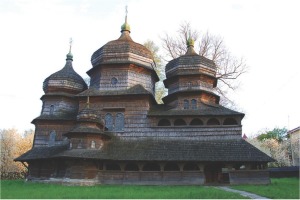. Introduction
St. George’s Orthodox Church (tserkva) situated at 23 Solonyi Stavok Street in Drohobych (N 49°20’51. 85, E 23°29’58. 08”) is one of the most precious pieces of historic wooden architecture in the Lviv region (Dzieduszycki, 1883; Brykowski, 1995; Koch, 1996). The current structure was built on the site of an earlier church. Written sources report various opinions as to the exact year of the church’s construction – citing either 1600 or 1657. There are many carvings on its walls dating from 1675, which prove that the church already existed in the second half of the 17th century. Entries in the Register of Saint George’s Tserkva indicate that the property was destroyed by fire in 1657 (Jurczenko, 1970; Lovgin, 1986; Mohytycz, 1996). St. George’s Orthodox Church, recently registered in the UNESCO World Heritage List, is a property of the Drohobych Regional Museum.
St. George’s Orthodox Church is a wooden, tripartite, log-built structure with three roofs (Fig. 1). It stands on a stone-built plinth wall and is aligned east–west. From the eastern side, its square nave (7.50 x 7.50 m) is adjoined by a faceted rectangular altar, with slanting walls and a small rectangular sacristy from the north. From the western side, it is adjoined by a rectangular narthex (for womenfolk). Adjacent to the nave’s southern and northern walls are two small, faceted cliroses that line up with the altar wall. The cloister on wooden pillars adjusted to the western walls of the cliroses engirdles the church from the north. The church walls are made of squared hewn logs, slightly slanting inwards and secured with pegs. The ends of the wall’s timbers are fastened with ordinary and hidden tenon joints. The altar is surrounded by a covering supported on the carved and profiled projecting ends of the wall’s timbers of the cliroses and the altar (Fig. 2).
Fig 2
Inside view with iconostas of St. George’s Orthodox Church in Drohobych. Photograph by P. Krąpiec.
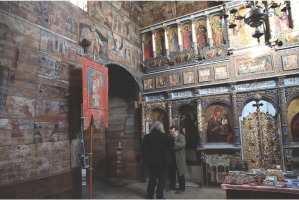
By the northern wall of the narthex, there is a steep staircase leading into the arcade, a second-tier gallery, which from three sides surrounds the rectangular matroneum above the narthex and adjoins the walls of the nave. Above the level of the top covering, the western part of the church transfers through the slanted triangular embossments of the quaternary layout to the octagonal one, terminating in a log-built octagonal dome. The altar part is of a similar construction, the only difference being that the passage is made from a pentahedral basis of the altar’s bottom.
The three main roofs are all covered with baroque domes of complicated forms surmounted with similarly shaped finials in the form of forged crosses. At the level of the frame’s bend, the polygonal cliroses have flat boarded ceilings and are covered with five-planed roofs crowned with small baroque domes with finials formed as forged crosses. The lower gallery is fenced with horizontal boards and the upper with vertical ones. It can be entered from the yard through three wide passages, from the south, west and north. The main church entrance is in the slanted northwest wall of the narthex. The front entrance door is wooden, bound with forged figured hinges, with an internal iron lock. The door is inserted into the old massive jambs. On the threshold coating, an inscription about the repair of the church in 1825 is carved.
At the nave’s southern wall, a ladder is situated, providing an exit into the cliroses wherefrom a passage leads to the choir gallery above the narthex. Also, the chapel has its separate entrance from the gallery of the second tier, arranged in the western wall.
On the whole, the composition of the southern and northern facades is dissymmetrical due to the bulk of galleries which surround the narthex and matroneum. At the same time, the arcade-like galleries’ enclosure facilitates the perception of the western section of the church. The sophisticated character of the shingling of the wall with shingles of different shapes, installation of profiled wooden cornices with dentils and blind arcades, and the baroque character of the domes make the temple look as majestic as a rich city church.
Although the Orthodox Church of St. George has been the subject of multiple studies (Dzieduszycki, 1883; Jurczenko, 1970; Lovgin, 1986; Mohytycz, 1996), there are no unequivocal data on the origins of this building. Its absolute dating was attempted with dendrochronological analysis, carried out in cooperation with the Drohobych Regional Museum, which manages the object.
. Materials and methods
Because of the status of the church and preferences of its management, the studies, undertaken in 2013, were mostly performed by a non-invasive method, based on macro-photography. Altogether, 40 construction elements from different parts of the structure, with legible perpendicular or tangential cross sections, were selected (locations are marked in Fig. 3). Macrophotographs made on a millimetre scale allowed for measurements of the annual growth widths, subsequently processed with the computer program CooRecorder (Cybis Elektronik and Data AB, Sweden; Maxwell, 2019).
Fig 3
Location of the construction elements of the church, subjected to the dendrochronological analysis.
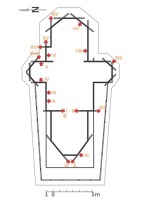
Dendrochronological analysis was also applied to the construction elements of the church dome, replaced during the renovation. Eight wood samples were taken in the form of slices. The samples were standardly pre-treated by cutting the surface layer of wood with knives to obtain a legible anatomical structure. Subsequently, in each of the samples prepared in this way, annual increments were measured, using the dendrochronological measurement apparatus DENDROLAB1.0 (Zielski and Krąpiec, 2004).
The annual increment sequences were measured and processed with a suite of computer programs, TREE-RINGS (Krawczyk and Krąpiec, 1995) and DPL (Holmes, 1994).
The statistical comparison of series was conducted using the TSAPWin program (Rinn, 2005). Each dendrochronological series of the church was initially compared with another of this structure. The statistical tests considered in the dendrochronological analysis are as follows:
t-values: adapted by Baillie and Pilcher (1973) to the analysis of time series. The dating has been considered reliable when the t-value is greater than 4–5, with corresponding high values of Gleichläufigkeit and statistical significance.
Gleichläufigkeit (Glk): a measure of the year-to-year agreement of the ring-growth tendencies of two chronologies, expressed as a percentage of cases of agreement from one year to the next (Eckstein and Bauch, 1969).
Statistical significance of Glk: this can be at 95.0%, 99.0%, or 99.9%, and it has been indicated here as *, ** and ***, respectively.
Based on the sequences representing the same time interval, local chronologies were constructed. Because of the lack of any standard chronology developed for western Ukraine, they were absolutely dated against the chronologies developed for central European areas (Becker and Giertz-Siebenlist, 1970; Heussner, 1996; Kyncl and Kyncl, 1996; Liebert et al., 1998; Krąpiec, 1998; Szychowska-Krąpiec, 2010).
The anatomical identification of the wood of both the samples taken in the form of slices as well as the photographed beams and planks with legible cross sections was carried out on the basis of macroscopic observations. Additionally, samples were taken from most of the elements analysed. Thin slices of wood from these samples were observed using transmitted light optical microscopy, in order to identify the species through the characterization of its anatomical features and a comparison with what was reported in the main reference texts regarding wood anatomy (Godet, 2008; Schweingruber, 1990).
. Results and discussion
The microscopic identification of the species through the characterization of its anatomical features revealed that most of the elements analysed were made of silver fir (Abies alba Mill.), whereas the basement beams were made of larch (Larix decidua Mill.) and oak wood (Quercus sp.) (see Tables 1 and 2). These tree species are traditionally used for structural purposes in central Europe (Szychowska-Krąpiec, 2007; Ważny, 2001; Zielski and Krąpiec, 2004).
Table 1
Dendrochronologically dated individual sample sequences of construction beams of St. George’s Orthodox Church in Drohobych.
Table 2
Dendrochronologically dated individual sample sequences of the repaired dome elements of St. George’s Orthodox Church in Drohobych.
The measurements resulted in dendrochronological sequences ranging from 50 to 128 years (Tables 1 and 2).
Computer correlations and visual comparisons of the dendrochronological sequences representing elements from the church structure allowed the identification of sequences from trees growing at the same time. They, in turn, allowed to construct a local silver fir chronology 3DRH_A01, spanning 159 years (Fig. 4).
Fig 4
Dendrochronologically dated individual sample sequences of construction elements of St. George’s Orthodox Church in Drohobych.
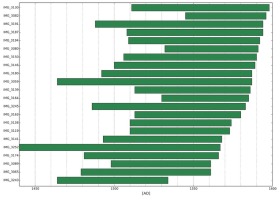
Cross-dating of the silver fir local chronology 3DRH_ A01 with the southern Polish master chronology 3ABSP1 for the Małopolska area (Fig. 5) has placed the last growth ring of the silver fir pattern at the year 1598 (t8.4, BP Glk 72 ***).
Fig 5
Comparison between the silver fir master chronology for Małopolska, in blue, and the dendrochronological series 3DRH_A01, in red. Logarithmic scale.
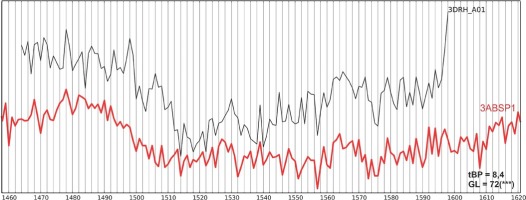
A slightly lower similarity of the chronology 3DRH _ A01 was noted at comparisons with the standards for areas further west:
Czech Republic (Kyncl & Kyncl 1996) tBP 5.6, Glk 69 ***.
Saxony and Thuringia (Heussner 1996) tBP 5.0, Glk 63 ***.
This should confirm earlier observations about the great dendrochronological potential of silver fir over wide geographical areas (Szychowska-Krąpiec, 2010; Büntgen et al., 2013).
The dating results of individual samples are presented in Table 1. The wooden walls of the church were made of fir beams, in most cases devoid of the last outermost rings, which allows only for dating terminus post quem. On the other hand, the dating results falling into a relatively narrow time interval of the last quarter of the century indicate a single construction phase. The exception is the sequence of sample IMG_3243 (1534 AD), perhaps indicating occasional, secondary use of older wood.
The youngest structural element, with the last outermost ring, indicates that the wood for the construction of the church was acquired at the end of the 1590s (1598 AD).
A separate group consists of sequences obtained by measuring samples from the dome elements replaced during the renovation at the end of the first decade of the 21st century (Table 2). They proved to be contemporaneous, although the silver fir chronology 3DRH1A is only 66 years in length (Fig. 6). Its absolute dating for 1756–1821 AD was based on high convergence with the chronologies from:
Fig 6
Dendrochronologically dated individual sample sequences of the repaired dome elements of St. George’s Orthodox Church in Drohobych.
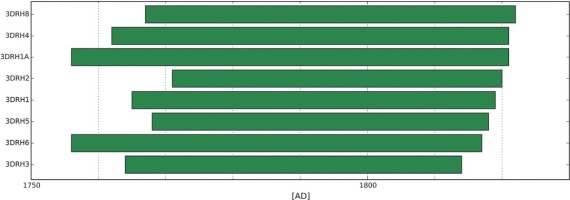
Małopolska (Szychowska-Krąpiec, 2010) tBP 5.3, Glk 74 *** (Fig. 7).
Eastern Austria (Liebert et al., 1998) tBP 5.1, Glk 72 ***.
Saxony and Thuringia (Heussner 1996) tBP 5.2, Glk 65 ***.
Fig 7
Comparison between the silver fir master chronology for Małopolska, in blue, and the dendrochronological series 3DRH1A, in red. Logarithmic scale.
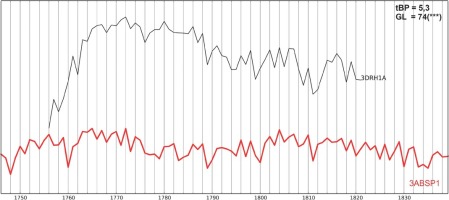
Most of the samples from the church dome retained their last rings. They represent trees felled between 1819 and 1822 AD. The dome renovation was carried out no earlier than 1823 AD and was most likely completed in 1825 AD, as it is indicated by the inscription mentioned earlier. Such a renovation date is in line with the views of art historians (Mohytycz 1996).
However, the construction date of the church, considered as the oldest urban temple in Drohobych, differs from the opinions presented hitherto. The foundation documents of the church have not been preserved. The earliest testimonies about St George’s Orthodox Church and its parish derive from the oldest judicial testimonies of the 15th century. It can be easily assumed that Deacon Myn’ from Drohobych, mentioned in a 1465 certificate (AGZ 1888, p. 453. − Nr 5611), belonged to St George’s Orthodox Church, which was the main church in Drohobych by the second half of the 16th century. More concrete documentary testimonies derive from the end of the century. They concern the kin of priests named Terletskyi in Drohobych. Thus, in 1497, Sen’ko from Terlo gained a half-acre field in Drohobych (MRPS 1915, no. 734), and in 1508, he also received a church beneficiary (MRPS 1915a, no. 8726), having initiated a hereditary kin of priests in Drohobych, who began their governing in the town’s main Ukrainian sanctuary (Tymoshenko, 2005; pp. 202–213). The last mention of Sen’ko is dated 1535, the year when Grigoriy/ Hrytsynko Terletskyi (MRPS 1915, no. 18692) is already mentioned.
In the manuscript collection of the privileges of Drohobych, there is a document by which Sigismund August confirmed in 1555 Sigismund I’s undated privilege. In it, the Ukrainian (Ruthenian) priests of St George’s Orthodox Church, namely Savka, Peter and Vasiok Terletskyi, are mentioned as well as an undated privilege of Władysław II and the privilege of Sigismund I of 1508 (AGAD). In 1510, three town churches and their parishes in Drohobych (Budzyński, 1990; p. 142) are mentioned. In 1514, an altercation between suburban parochial priests over the borders of their parishes begun. It ended only in 1537 after a royal certificate had been issued. In the opinion of many researchers, the roots of the dispute are much deeper, as Hrytsynko Terletskyi referred to the privileges of Kings Jan Olbracht and Alexander. Szaraniewicz (1875, p. 52), who had at his disposal the sources which were later lost, also asserted that in 1508, Sigismund had confirmed the old Władysław II Jagiello’s privilege of 1407 to Senko Terletskyi. Thus, in all probability, the earliest written fixation of St George’s Church in Drohobych and its parish is dated pre-1407.
No data on the temple building from 1407 to the beginning of the 17th century are available. What is clear is that it was a wooden church of an unknown architecture. Since the beginning of the 17th century, the minute book of the parish sittings was kept in the parish and the local fraternity, and its first record (from among those preserved) is dated to 1657 (Isaievych, 1972; pp. 27–28; Registers...). The hand-written book gives unique information on the church, its arrangement and renovation after a catastrophe in the middle of the 17th century. The initial record of the case of 15 April 1657 informs that after the church destruction, two members of the brotherhood were elected (Vasyliy Antonovych and Ivan Zakharchyn) who were to organize a collection (contribution of 3 guilders) for the temple’s restoration. For that reason, the wooden church in the village of Nadiyevo (near the town of Dolyna) was purchased. It is necessary to note that the quoted fragment of the brotherhood’s book was not met with a favourable reception: many researches even concluded that in 1657, the church was actually restored (or reconstructed). In clarifying the situation regarding the restoration of the temple building, Priest Vasyliy Terletskyi’s will is of exceptional value. It says as follows: “Since the brotherhood, after the first St. George’s Church had been burnt down, erected and built the present one with their own means and costs, so the church is now their own, while the cemetery, or the ground on which the church is built, I, therefore, bequeath and give for ever to that brotherhood...” (CSHAUL). Hence, by the time Vasyliy Terletskyi made his will (December 1680), the process of either the construction or the reconstruction of the church had already been completed.
Taking into account all the above, dendrochronological dating of the structural elements of St. George’s Orthodox Church indicates that the church purchased in Nadiyevo in 1657 could have been the basis for building development and/or reconstruction, only adapted to new conditions. This original structure was most likely erected just after 1598 AD.
. Conclusion
Dendrochronological studies of the construction timber elements of St. George’s Orthodox Church resulted in the construction of silver fir local chronologies dated to the following years: 1440–1598 AD (3DRH_A01) and 1756–1821 (3DRH1A). The patterns produced are highly convergent with the standard patterns for southern Poland, Czechia, eastern Austria and south-western Germany. This indicates a great dendrochronological potential of the silver fir, over wide geographical areas.
Dendrochronological dating of the structural elements of St. George’s Orthodox Church indicates that the church in Nadiyevo, erected just after 1598 AD and purchased in 1657, could have been the basis for its building, development and/or reconstruction. The dome of St. George’s Orthodox Church was renovated in the years 1823–25 AD.
